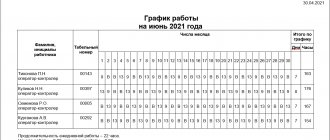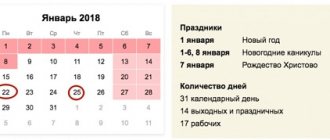The concept of a shift schedule
Shift work, 2/2 shift schedule - this, as many employers claim, is a very common mode. You need to work in two, three, four shifts, which are introduced if the duration of production processes is higher than permissible during daily work, as well as for the most efficient use of equipment and increasing production volumes. With the help of this mode, the uninterrupted operation of the organization is ensured. As a rule, to ensure this format, you need to organize 3 teams, sometimes 4.
Now that you know what a 2/2 work schedule is, let’s look at its features in more detail. The days of operation in this mode during the week will also differ from usual. When establishing a shift format in an organization, the employer must form several teams. They work in turns, which makes it possible to ensure a smooth process. If the institution is small, employees can work one at a time, replacing each other. This is possible in areas with simple processes. Answering the question: what is a 2-by-2 schedule? The main thing is to not allow an employee to work more than one shift in a row.
A two-by-two work schedule is one of the possible options for shift work. This algorithm is the most popular in practical activities.
A special feature of the regime is that the length of the working day goes beyond the 8 hours required for a five-day week. You must be present at the workplace both on weekdays and weekends. If an employee working in shift mode falls on a holiday, the work will be paid in a single amount. A duty period of 10 or 12 hours is not considered overtime, and no additional payments are established. All of these provisions are provided for within the framework of the employment agreement.
Breaks in work when scheduled every three days
The second important nuance is the competent organization of the employee’s work. During working hours, he is entitled to food breaks and other regulated periods of rest, since without this, for 24 hours in a row, it is difficult for an employee to perform labor functions effectively and fully.
Labor legislation also provided for this nuance, stipulating the employer’s obligation to provide the employee with breaks for rest and food during the working day. This period of time is limited: no less than 30 minutes and no more than two hours per working day. These breaks are not included in working hours (Article 108 of the Labor Code of the Russian Federation)
Time restrictions provided for in Art. 108 of the Labor Code of the Russian Federation, every employer is obliged to comply. The specific duration of breaks and the time they are provided within 24 working hours are prescribed in the PVTR. For example, you can set two breaks of 60 minutes, four breaks of 30 minutes, or some other combination of number and duration.
If, due to production (work) conditions, it is impossible to provide a break, the employer is obliged to provide the employee with the opportunity to rest and eat food during working hours (Article 108 of the Labor Code of the Russian Federation). A list of such work, as well as places for rest and eating are established in the PVTR.
Taking into account the above, with a work schedule of “every three days”, the employee’s time sheet may show either 24 hours (in a situation where there are no breaks excluded from working time due to working conditions) or a shorter period of time (for example, 22 hours, when the employee can be absent from work). places and two-hour breaks will not be included in working hours).
The legislative framework
The format of work in the 2-by-2 mode - what is the work schedule, what are its features established by the legislator? Labor Code of the Russian Federation in Art. 103 allows for the installation of a shift regime if the process in the institution is to provide round-the-clock services. The head of the enterprise creates and regulates schedules. It is important to remember the prohibition on exceeding labor standards: during the week, an employee works the same as the standard working week of 40 hours (but in general, more is possible, you need to look at the accounting period, usually with this mode, summarized accounting of working hours).
Work activities in shift mode (this is a variant of what schedule 2/2 is called) include the following articles of the Labor Code of the Russian Federation:
- Art. 102 - work in a flexible format;
- Art. 103 - shift schedule;
- Art. 104 — accounting of labor time;
- Art. 105 - permitted methods of redistributing labor time.
Content
When developing a schedule, the employer is obliged to consider the wishes of the representative body of subordinates. This procedure is established by Article 372 of the Labor Code. Given a certain length of working time, the shift schedule for 2021 is usually set every month. But since this issue is not reflected in the law, the frequency may be different.
The schedule implies the exact start time, duration of the working day, legal breaks for rest and food, and the end time of the work shift. In addition, the schedule contains information about the time between shifts and weekly rest.
There is no specifically established form of the schedule. When approving it, you can rely on the report card form No. T-13. The necessary changes are also made there.
If a change in the shift schedule is expected, the staff should be notified of this no later than 1 month before the official introduction. Otherwise, the employee cannot be held accountable for failure to comply with the new routine. In the forms where employees agree to the updated shift schedule, there must be a certain line where they put the date and personal signature. This document serves as confirmation that staff are notified of the innovations. The worker has the right to see the shift schedule, a sample of which must be received in hand.
Who works on a shift schedule
Shift mode - as the 2-by-2 work schedule is called, is used in institutions where you need to work around the clock. As a rule, these can be:
- emergency response services (EMERCOM, police, doctors), because their work is needed at any moment;
- non-stop cycle enterprises;
- institutions serving the population (hotels, cafes, security companies);
- transport companies (including train stations, airports);
- trading enterprises (if they provide services to the public 24/7).
The list is far from exhaustive; however, an organization can switch to shift mode at any time if the need arises.
Features of shift work
Features of labor processes influence the established regime. However, in any case, it must be carried out in compliance with the conditions established by current legislation.
The schedule can be entered in relation to different time periods. Using summarized accounting, the employer establishes an accounting period.
The replacement format is introduced for a specified period or on an ongoing basis. The main thing is to determine the employee’s working time, which is not higher than the established duration for such a category. This means that neither overtime nor overtime is included in the plan (they are entered in the time sheet). It is important to consider that adequate rest must be provided during a 12-hour shift.
It is imperative to follow the provisions of Art. 94 of the Labor Code of the Russian Federation and take into account the employee’s membership in those groups for which a special work shift duration is determined, including a reduced duration.
The duration of the shift varies, depending on the needs of the organization. However, days off must be provided exactly according to the work plan. Working under shift conditions does not deprive the right to annual leave and paid sick leave.
The Labor Code of the Russian Federation does not establish the duration of the period for which a shift regime is drawn up. As a rule, this is one month, but the shift can last for a year.
Is a 4/2/11 hour work schedule legal?
Normal working hours cannot exceed 40 hours per week.
Quote:
Labor Code of the Russian Federation, Article 91. The concept of working time. Normal working hours
Guides to personnel issues and labor disputes. Questions of application of Art. 91 Labor Code of the Russian Federation
Working time is the time during which an employee, in accordance with internal labor regulations and the terms of the employment contract, must perform labor duties, as well as other periods of time that, in accordance with this Code, other federal laws and other regulatory legal acts of the Russian Federation, relate to working hours.
Normal working hours cannot exceed 40 hours per week.
The procedure for calculating the norm of working time for certain calendar periods (month, quarter, year), depending on the established duration of working time per week, is determined by the federal executive body exercising the functions of developing state policy and legal regulation in the field of labor.
The employer is required to keep records of the time actually worked by each employee.
Labor Code of the Russian Federation, Article 99. Overtime (as amended by Federal Law dated June 30, 2006 N 90-FZ) (see text in the previous edition)
Guide to HR issues. Questions of application of Art. 99 Labor Code of the Russian Federation
Overtime work is work performed by an employee at the initiative of the employer outside the working hours established for the employee: daily work (shift), and in the case of cumulative accounting of working hours - in excess of the normal number of working hours for the accounting period.
An employer's involvement of an employee in overtime work is permitted with his written consent in the following cases:
1) if necessary, perform (finish) work that has begun, which, due to an unforeseen delay due to technical production conditions, could not be performed (finished) during the working hours established for the employee, if failure to perform (non-complete) this work may lead to damage or destruction of property the employer (including the property of third parties located at the employer, if the employer is responsible for the safety of this property), state or municipal property, or create a threat to the life and health of people;
2) when carrying out temporary work on the repair and restoration of mechanisms or structures in cases where their malfunction may cause the cessation of work for a significant number of workers;
3) to continue work if the replacement employee fails to appear, if the work does not allow a break. In these cases, the employer is obliged to immediately take measures to replace the shift worker with another employee.
An employer’s involvement of an employee in overtime work without his consent is permitted in the following cases:
1) when carrying out work necessary to prevent a catastrophe, industrial accident or eliminate the consequences of a catastrophe, industrial accident or natural disaster;
2) when carrying out socially necessary work to eliminate unforeseen circumstances that disrupt the normal functioning of centralized hot water supply, cold water supply and (or) sewerage systems, gas supply systems, heat supply, lighting, transport, communications; (as amended by Federal Law dated December 7, 2011 N 417-FZ) (see text in the previous edition)
3) when performing work the need for which is due to the introduction of a state of emergency or martial law, as well as urgent work in emergency circumstances, that is, in the event of a disaster or threat of disaster (fires, floods, famine, earthquakes, epidemics or epizootics) and in other cases, threatening the life or normal living conditions of the entire population or part of it.
In other cases, involvement in overtime work is permitted with the written consent of the employee and taking into account the opinion of the elected body of the primary trade union organization.
Pregnant women, workers under the age of eighteen, and other categories of workers are not allowed to work overtime in accordance with this Code and other federal laws. Involvement of disabled people and women with children under three years of age in overtime work is allowed only with their written consent and provided that this is not prohibited for them due to health reasons in accordance with a medical report issued in the manner established by federal laws and other regulations legal acts of the Russian Federation. At the same time, disabled people and women with children under three years of age must be informed of their right to refuse overtime work upon signature.
The duration of overtime work should not exceed 4 hours for each employee for two consecutive days and 120 hours per year.
The employer is required to ensure that each employee's overtime hours are accurately recorded.
Opening hours
The legislator requires that the work schedule during the day be distributed between at least 2 shifts of workers. The duration of one shift is no more than 12 hours.
The employer can choose the most optimal option for production:
- two shifts - the production process is divided into two components: day and night;
- four teams - employees work in the format: night shift, day shift, weekend;
- 72 hours - employees work in the following format: 2 shifts a day, 2 days off, 2 shifts in the evening, 1 day off, 2 shifts at night, 3 days off.
Night shift
As a rule, the working day begins at 8 am or, accordingly, in the evening. An employee does not have the right to voluntarily change the schedule without agreeing with the employer. You can only work on your own shift.
The employer must monitor the uniform rotation of teams: each team works in turns on night and day shifts.
Labor organization algorithms may be different. So, an employee can work during the day, then in the evening or immediately at night. A format of 2 days during the day, 2 days at night is possible.
Features of working at night
A night shift is one the main part of which occurs at night (from 22:00 to 06:00) or evening (for example, from 20-00 to 08-00). Night duty should be an hour shorter than day duty. This does not apply to those hired to work exclusively at night.
It is prohibited to work on the night shift:
- under 18 years of age;
- pregnant women.
Women with children under 3 years of age, disabled people, single parents, and those caring for the sick can work at night (only with written consent).
Labor Code of the Russian Federation in Art. 154 determines the mandatory use of increased coefficients in relation to hours worked by an employee at night. The minimum amount is 20%. The maximum amount of additional payment and its determination is the right of the manager.
In general, Decree of the Government of the Russian Federation dated July 22, 2008 No. 554 establishes the same minimum amount of extra pay for night work for all employees, or rather a 20 percent extra pay for each working hour.
The specific amount of the increase in payment for going out at night is established:
- collective or labor agreement;
- local regulations.
The additional payment is calculated from the hourly tariff rate (salary per hour of work), that is, when establishing an additional payment for work at night, other additional payments and (or) allowances should not be taken into account.
Who should not be included in the work schedule every three days
The work schedule “in three days” cannot include workers who are subject to prohibitions and restrictions established by labor legislation:
- a ban on working on the night shift (for example, for pregnant employees under Part 5 of Article 96, Part 1 of Article 259 of the Labor Code of the Russian Federation);
- limitation on the duration of daily work (for example, for minor employees under Article 94 of the Labor Code of the Russian Federation).
Useful information from ConsultantPlus
In the materials of the legal reference system you will find the necessary tips:
– What are the features of the working hours of a minor worker; – Guarantees for pregnant women at work.
How is it paid?
Another logical question: 2/2 work schedule - how is it paid? Work time recording in a shift format is designed for short periods of time, usually a month. Accordingly, payment is calculated according to the number of shifts worked during the accounting period, that is, for the one for which the shift regime is established.
The schedule must be drawn up so that the employee develops a norm taking into account annual vacations.
The average working month in 2021 will be 164.17 hours with a 40-hour week. Overtime activities are subject to additional payment. In case of shortcomings, payment is deducted or paid in proportion to the time worked.
A work shift or part of it that falls according to the schedule on Saturday or Sunday is paid as a regular working day (Article 111 of the Labor Code of the Russian Federation). A shift on a day that falls on a holiday is subject to double payment. Work on a day that is a day off can be compensated by time off; hours of work are paid at a single rate. If the employee does not take time off, payment will be made at double the rate.
Thus, the enterprise has the right to decide whether to choose a shift mode in the 2/2 option or another. The main thing is to comply with working time standards.
Schedule 2/2 with a shift duration of 12 hours violates the employee’s right to rest
Experts from the GARANT Legal Consulting Service came to this conclusion, explaining it as follows. As a general rule, the working hours are set by the employer in the internal labor regulations (Article 100, Article 189 of the Labor Code). According to current legislation, normal working hours cannot exceed 40 hours per week (Part 2 of Article 91 of the Labor Code of the Russian Federation). It is noted that in most cases, labor legislation does not contain restrictions regarding the duration of the working day, with the exception of workers for whom the duration of daily work (shift) is legally determined (Article 94 of the Labor Code of the Russian Federation) and workers for whom, due to the special nature of the work, it is established as weekly, as well as daily working hours (Part 2 of Article 100 of the Labor Code of the Russian Federation). Consequently, for other employees, the employer can establish any length of the working day in the internal labor regulations or in the employment contract.
Does the rule on reducing working hours by an hour on the eve of a non-working holiday apply to part-time workers? The answer is in the Encyclopedia of Solutions. Labor relations, personnel" Internet version of the GARANT system. Get full access for 3 days for free!
Get access
However, it is worth taking into account the employee’s right to daily (between shifts) rest (Article 107 of the Labor Code of the Russian Federation). The duration of such rest is not specified in the Labor Code of the Russian Federation, but the rule of the Soviet period continues to be applied that the duration of daily (between shifts) rest together with the lunch break must be no less than double the duration of work on the working day (shift) preceding the rest (p .11 resolution of the Council of People's Commissars of the USSR of September 24, 1929 “On working time and rest time in enterprises and institutions switching to a continuous production week”). The application of this rule is confirmed by current judicial practice (decision of the Krasnochikoysky District Court of the Trans-Baikal Territory dated April 14, 2014 in case No. 2-106/2014, appeal ruling of the Investigative Committee for civil cases of the Rostov Regional Court dated March 31, 2014 in case No. 33-4219 /2014, cassation ruling of the Investigative Committee for civil cases of the Pskov Regional Court in case No. 33-1085/2011).
Thus, experts have come to the conclusion that the duration of daily rest for a working day of 12 hours, together with lunch time, should be at least 24 hours, and immediately after work. If an employee works two days in a row and then rests for two days, while the working day is 12 hours long, and work on both the first and second days begins at the same time, his right to daily rest is violated.
Let us note that the employee’s consent to work according to such a schedule cannot serve as a basis for establishing a working time schedule that worsens the employee’s position in comparison with labor legislation (Article 9 of the Labor Code of the Russian Federation).







